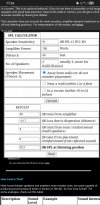That won't matter much because you are using the amp as a subwoofer amp so the amp will be amplifying the whole low frequency range full time. If the contents you play have lots of bass, the amp will have to work hard, limited bandwidth or not. Good subwoofer amps are typically rated hundreds of (even over 1,000 W) watts for good reasons. Even the entry level SVS PB1000 is rated 300 W.
In my opinion, by now, you have the information you need to make your decision. You seem still concerned if the DRA amp has enough power, but the simple fact is, while most people won't use a relatively low output integrated amp with an AVR to drive subwoofers, almost any decent 50 W amp can drive any speaker or subwoofer if you don't listen too loud and don't sit too far.
Try an online calculator to estimate your actual estimated power need if you want to have a better idea:

www.crownaudio.com
I don't know the impedance and phase angle characteristics of your subwoofers. If they are 4 ohm nominal, then whatever those calculators results show, double it, and it will be the "watts" you need. That's because those calculators are based on using 8 ohm loads.
Again, it is usually not a good idea to use such an integrated amp (especially one such as the DRA-800H) as a power amp for subwoofers, but you seem so fixated on going this route, so good luck to you. A weird case as it seems, you will be fine as long as your power need based on your specific listening habits and distance is well within the amp's capability, that is about 100 W 8 ohms, less for 4 ohms (except for short term, peaks etc.).


